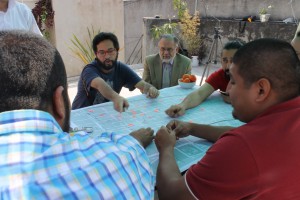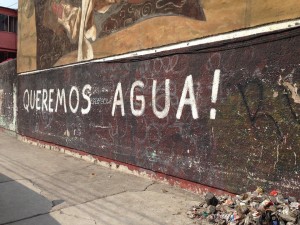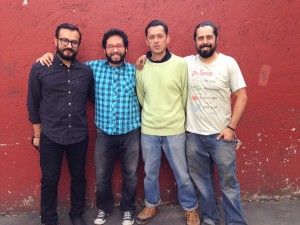MICROURBANISM IN MEGAPOLIS
MICROURBANISM IN MEGAPOLIS
Water and security; main issues of the community in Mexico City
 Mexico City, November 21 2014: A project Down by the water (Abajo por el agua) by the Slovenian collective KUD C3 (Mateja Kurir, Bostjan Bugarič) is carried out in barrio Santa Maria la Ribera. The project is opening important community issues, such as the right to water and the prevention of crime and violence in the public space by promoting the participation of residents in local scale. Such urban interventions at the level of microurbanism allow the residents an active creation of the new urban environment. Mexico City, a megapolis with twenty millions of inhabitants, built on a lake with many water tributaries, is today facing a massive problem of water distribution. As such it could be a case study for accessing water in all mega-urban centers in the future.
Mexico City, November 21 2014: A project Down by the water (Abajo por el agua) by the Slovenian collective KUD C3 (Mateja Kurir, Bostjan Bugarič) is carried out in barrio Santa Maria la Ribera. The project is opening important community issues, such as the right to water and the prevention of crime and violence in the public space by promoting the participation of residents in local scale. Such urban interventions at the level of microurbanism allow the residents an active creation of the new urban environment. Mexico City, a megapolis with twenty millions of inhabitants, built on a lake with many water tributaries, is today facing a massive problem of water distribution. As such it could be a case study for accessing water in all mega-urban centers in the future.
 Graphite “We demand water!” in barrio Santa Maria la Ribera (Mexico City).
Graphite “We demand water!” in barrio Santa Maria la Ribera (Mexico City).
The project Down by the water is an intervention at the level of microurbanism, which allows long-term recuperation of community with the participation of many local partners. With the transfer of knowledge and good practice of the project Zalograd (Ljubljana – Slovenia, EU), it focuses on researching the current urban reality and development of a long term vision for the barrio of Santa Maria la Ribera on the theme of water.
KUD C3 had conduced interviews with residents of the neighborhood in collaboration with students of UAM and therefore recognized as an important theme the violence and security in public space. With the participation and integration of local partners (SPAZI, UAM, Cineteca, Mi Verde Morada, Consejo Cultural Consultivo Ciudadano, Casa Imelda, Libreria Bodet) were carried out first steps for preparation of alternative development scenario, which will help to the community to resist the current process of gentrification.
 About Barrio Santa Maria la Ribera
About Barrio Santa Maria la Ribera
Santa María la Ribera is a barrio located in the Cuauhtémoc borough of Mexico City, just west of the historic center. It was created in the late 19th century as the first urbanely planned barrio in Mexico City for the affluent who wanted homes outside of the city limits. Urban and cultural highlight of the barrio were reached between 1910 and 1930. After 1930 they started new ways of housing, which was brought by the middle class. Urban structure has changed dramatically in 1950, living conditions have worsened due to the construction of large residential buildings. Mass migration of poorer people to the barrio begun after the earthquake in 1985. The number of inhabitants increased in an extremely short period from 20,000 to 60,000. Today it is the one of the few representative barrio in the district of Mexico City with many craft workshops and small shops, that was typical for the urban tissue of the city in the 20th century. Barrios with this kind of urban, economical and social structure in Mexico City had radically transform in the past 10 years due the process of gentrification.
Contact:
KUD C3/ Mateja Kurir in Boštjan Bugarič
bostjanbbugaric@gmail.com
bostebugaric
fb.com/KUDC3
